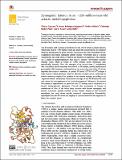Por favor, use este identificador para citar o enlazar a este item:
http://hdl.handle.net/10261/296009COMPARTIR / EXPORTAR:
 SHARE SHARE
 CORE
BASE CORE
BASE
|
|
| Visualizar otros formatos: MARC | Dublin Core | RDF | ORE | MODS | METS | DIDL | DATACITE | |

| Título: | Zymogenic latency in an ∼250-million-year-old astacin metallopeptidase |
Autor: | Guevara, Tibisay CSIC ORCID ; Rodríguez-Banqueri, Arturo CSIC ORCID; Stöcker, Walter; Becker-Pauly, C.; Gomis-Rüth, F. Xavier CSIC ORCID | Palabras clave: | Metallopeptidase zymogenic latency Astacin metallopeptidase Limulus polyphemus Horseshoe crab Aspartate-switch mechanism Catalytic domain Pro-peptide |
Fecha de publicación: | 2022 | Editor: | International Union of Crystallography | Citación: | Acta Crystallographica Section D: Structural Biology 78: 1347-1357 (2022) | Resumen: | The horseshoe crab Limulus polyphemus is one of few extant Limulus species, which date back to ∼250 million years ago under the conservation of a common Bauplan documented by fossil records. It possesses the only proteolytic blood-coagulation and innate immunity system outside vertebrates and is a model organism for the study of the evolution and function of peptidases. The astacins are a family of metallopeptidases that share a central ∼200-residue catalytic domain (CD), which is found in >1000 species across holozoans and, sporadically, bacteria. Here, the zymogen of an astacin from L. polyphemus was crystallized and its structure was solved. A 34-residue, mostly unstructured pro-peptide (PP) traverses, and thus blocks, the active-site cleft of the CD in the opposite direction to a substrate. A central `PP motif' (F35-E-G-D-I39) adopts a loop structure which positions Asp38 to bind the catalytic metal, replacing the solvent molecule required for catalysis in the mature enzyme according to an `aspartate-switch' mechanism. Maturation cleavage of the PP liberates the cleft and causes the rearrangement of an `activation segment'. Moreover, the mature N-terminus is repositioned to penetrate the CD moiety and is anchored to a buried `family-specific' glutamate. Overall, this mechanism of latency is reminiscent of that of the other three astacins with known zymogenic and mature structures, namely crayfish astacin, human meprin β and bacterial myroilysin, but each shows specific structural characteristics. Remarkably, myroilysin lacks the PP motif and employs a cysteine instead of the aspartate to block the catalytic metal. | Versión del editor: | http://dx.doi.org/10.1107/S2059798322009688 | URI: | http://hdl.handle.net/10261/296009 | DOI: | 10.1107/S2059798322009688 | Identificadores: | doi: 10.1107/S2059798322009688 e-issn: 2059-7983 |
| Aparece en las colecciones: | (IBMB) Artículos |
Ficheros en este ítem:
| Fichero | Descripción | Tamaño | Formato | |
|---|---|---|---|---|
| Zymogenic latency_Guevara_PV_Art2022.pdf | 2,46 MB | Adobe PDF |  Visualizar/Abrir |
CORE Recommender
Page view(s)
23
checked on 29-abr-2024
Download(s)
14
checked on 29-abr-2024
Google ScholarTM
Check
Altmetric
Altmetric
Este item está licenciado bajo una Licencia Creative Commons

